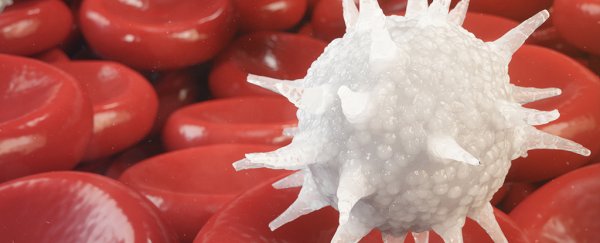Blood cells altered to block HIV have safely stuck around for more than a year and a half after they were transplanted into a volunteer, raising hopes of a more accessible cure.
While it's not the first time HIV-resistant blood cells have been used to fight the infection, this time researchers used CRISPR in a new way. Their success could open this therapy up as a safe and effective treatment for an even greater number of people.
Encouraged by their results in an earlier study on mice, Chinese researchers genetically modified hematopoietic stem and progenitor cells provided by a donor and transplanted them into a 27-year-old man who had two diagnoses - an acute form of leukaemia and was HIV positive.
In this case, having the blood cancer alongside HIV was a crucial part of the patient being fit for this study, as that allowed the team to use the cell transplantation procedure as treatment, except with an added CRISPR twist.
More than 19 months after the altered cells were transplanted into the patient's body, the investigation team concluded the new transplant had not only taken hold, but it also hadn't resulted in any side effects that can be linked with the editing process.
Months after receiving the HIV-resistant donor tissue, the patient stopped taking his course of virus-busting medications so the researchers could check whether the portion of resistant blood cells made any difference in the pathogen's ability to replicate.
Unfortunately in this case, it wasn't to be. The man's viral load began to climb back up again, forcing him to return to his usual assortment of anti-retroviral drugs.
On closer inspection, it turned out the HIV-resistant cells had replaced little more than 5 percent of the patient's lymphocytes, going some way to explaining the low efficiency of the treatment.
But even if the volunteer still requires ongoing anti-retroviral treatment to manage his infection, the fact the genetically altered donor cells stuck around so long without a problem is counted as a significant win by the research team.
The method used a cutting-edge technology known as CRISPR-Cas9 to break the gene behind a receptor in the white cell's membrane called CCR5, effectively changing the locks HIV uses to infiltrate and destroy the immune cells.
A mutated version of this receptor already occurs naturally, offering a suitable level of resistance in those fortunate enough to have at least one copy of the variant gene.
Ever since the discovery of this twisted form of the CCR5 receptor, it has been the subject of intense research into future generations of HIV treatments.
Initially researchers focussed on transplanting stem cells from donors with the mutant form of the gene, demonstrating a remarkable level of success some have equated with an actual cure.
Yet advances in DNA editing have tempted a number of researchers to look beyond naturally occurring mutants and artificially produce HIV-resistant versions by knocking out bits of CCR5's genetic sequence.
In its most controversial form, a Chinese researcher claimed in 2018 to have edited the CCR5 gene in the embryonic cells of twin girls. The infamous study has since highlighted the health risks and ethical challenges associated with gene editing technology, especially on such a fundamental level.
Applied to donated tissues, there still remains fear that CRISPR could unintentionally give rise to significant levels of damage that turn innocent cells into something less benign.
Treading lightly, this latest study set out simply to show whether the transfer of CRISPR-edited blood stem cells could be done safely and efficiently. There's still a long way to go before we'll see this kind of therapy being used conventionally, if at all.
Not only do researchers need to find more reliable ways to alter the CCR5 gene, they need to find more effective methods for transplanting the tissue to increase the chance it will contribute a significant number of white blood cells.
Recent studies suggest that having two broken copies of the CCR5 gene might not be so great for life expectancy, even if it does help you avoid an infection with HIV.
Understanding exactly why this is the case would be an important step in demonstrating this kind of treatment is ultimately safe. But the fact remains, tens of millions of people all around the world carry the virus. They come from all walks of life, all ages, with all kinds of bodies.
To put an end to the pandemic, we'll need treatments that are effective and can suit not just a fortunate handful, but work for all of them.
This research was published in the New England Journal of Medicine.
